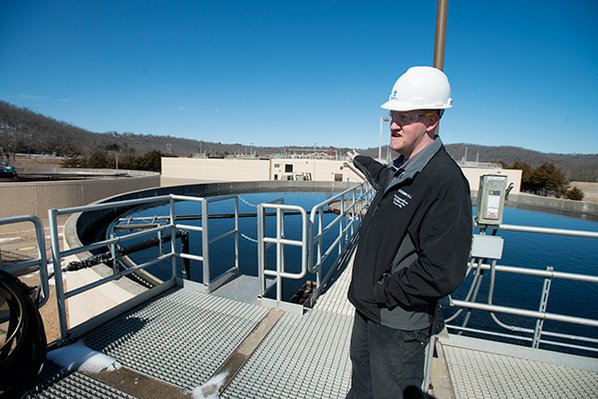River’s effluent limits appealed
Hearing for Fayetteville set
Posted: February 12, 2014 at 5 a.m.

NWA Media/ANTHONY REYES Tim Tinsley, operations supervisor for the Paul R. Noland Waste Water Treatment Plant, talks about one of the plant’s holding tanks Tuesday during a brief tour of the plant in Fayetteville. The 888,000 gallon tank settles material to the bottom as part of the treatment process for waste water. The city of Fayetteville is requesting a modification to a state regulation that will allow them to continue discharging the current level of minerals into the White River, instead of spending hundreds of millions of dollars retooling their wastewater treatment system.
Fayetteville is asking regulators to modify drinking water regulations to allow a greater discharge of minerals into the White River.
The request, known as a “petition to initiate 3rd-party rulemaking,” was filed in October with the Arkansas Pollution Control and Ecology Commission, which will hold a public hearing on the request Thursday in Fayetteville.
The commission is a rule-making body that governs the state Department of Environmental Quality.
According to documents filed with the department, the request centers on the Paul R. Noland Wastewater Treatment Plant, located about 5 miles east of Fayetteville on Fox Hunter Road. The plant is one of Fayetteville’s two municipal wastewater treatment plants, and it also treats wastewater from additional municipalities including Elkins and Greenland.
The Noland plant is permitted by the state to discharge treated wastewater into the White River downstream from the confluencewith Richland Creek. State regulations limit mineral concentrations of chlorides and sulphates to 250 milligrams per liter each, and 500 milligrams per liter of “total dissolved solids,” a combination of the two, for waterways designated as current or potential drinking water sources. The portion of the White River in question, however, has lower limitations of 20 milligrams each of chlorides and sulfates, and 160 milligrams of total dissolved solids per liter of water.
Department spokesman Katherine Benenati said the minerals standards for that portion of the upper White River are “site-specific” and were established in the 1970s.
Fayetteville outsources management of its wastewater treatment systems to CH2M Hill, a Colorado-based environmental consulting and engineering corporation. Billy Ammons, regional manager for CH2M, said the petition seeks to raise the allowable concentration of salt minerals to slightly below what the plant is currently discharging.
“We’re asking for numbers that will allow us to be just barely ‘within permit,’” Ammons said. “We’ve been discharging into this river for a long time, and we have a $300,000 to $400,000 study to prove, every which way from Sunday, that we’re not affecting the aquatic wildlife.”
According to department documents, Fayetteville is requesting that the discharge limits on chlorides be raised from 20 to 60 milligrams, the limit on sulfates from 20 to 100 milligrams and the limit on total dissolved solids from 160 to 440 milligrams per liter of water.
The Noland Plant received a wastewater discharge permit in 1990, according to department records. In 2008, the department placed the stream segment near the plant on its list of impaired streams. The federal Clean Water Act requires the department to update the list every two years. When the city renewed its five-year discharge permit in March 2013, the department assigned the city a five-year compliance schedule for reducing the mineral concentrations, Ammons said.
The minerals are not typically considered a biologicalhazard, Ammons said, and are generally introduced into municipal water through residents’ food waste.
“It’s nothing in the treatment plant; it’s all what we put down the drain,” Ammons said. “It’s a product of the American diet - it’s all salts.”
But removing the minerals from the wastewater requires expensive upgrades to existing treatment methods, and other Arkansas municipalities and industries have sought exceptions to the mineral discharge standards. In June, Huntsville filed a similar petition to avoid spending tens of millions of dollars to upgrade its treatment system, and it spent several hundred thousand dollars to commission a scientific study in support of the request. There are currently petitions from five municipalities and businesses before the Pollution Control and Ecology Commission seeking modifications to the regulation.
Ammons said it would cost about $45 million to retool the Noland Plant to remove the minerals through a process known as “reverse osmosis,” and $2 million to $3 million in annual upkeep thereafter.
During the 2013 legislative session, state Rep. Andy Davis, R-Little Rock, introduced House Bill 1929, which would amend Arkansas Code Annotated 8-4-202 to remove the default drinking water designation from Arkansas waterways not already being used as such, and change other aspects of how mineral concentrations are calculated.
While the bill had support from industry groups including the Arkansas Environmental Federation, officials with the federal Environmental Protection Agency warned repeatedly during the legislative process that the act’s language conflicted with requirements of the Clean Water Act. Although the bill became law, Act 954 was quickly repealed in a special session after the EPA began restricting the permit authority of Arkansas regulators.
The public hearing will be held at 6 p.m. Thursday in the Walker Community Room of the Fayetteville Public Library. Interested parties will have the opportunity to enter oral and written statements into the public record for consideration as to whether the commission should modify the regulation.
Northwest Arkansas, Pages 7 on 02/12/2014



No comments:
Post a Comment